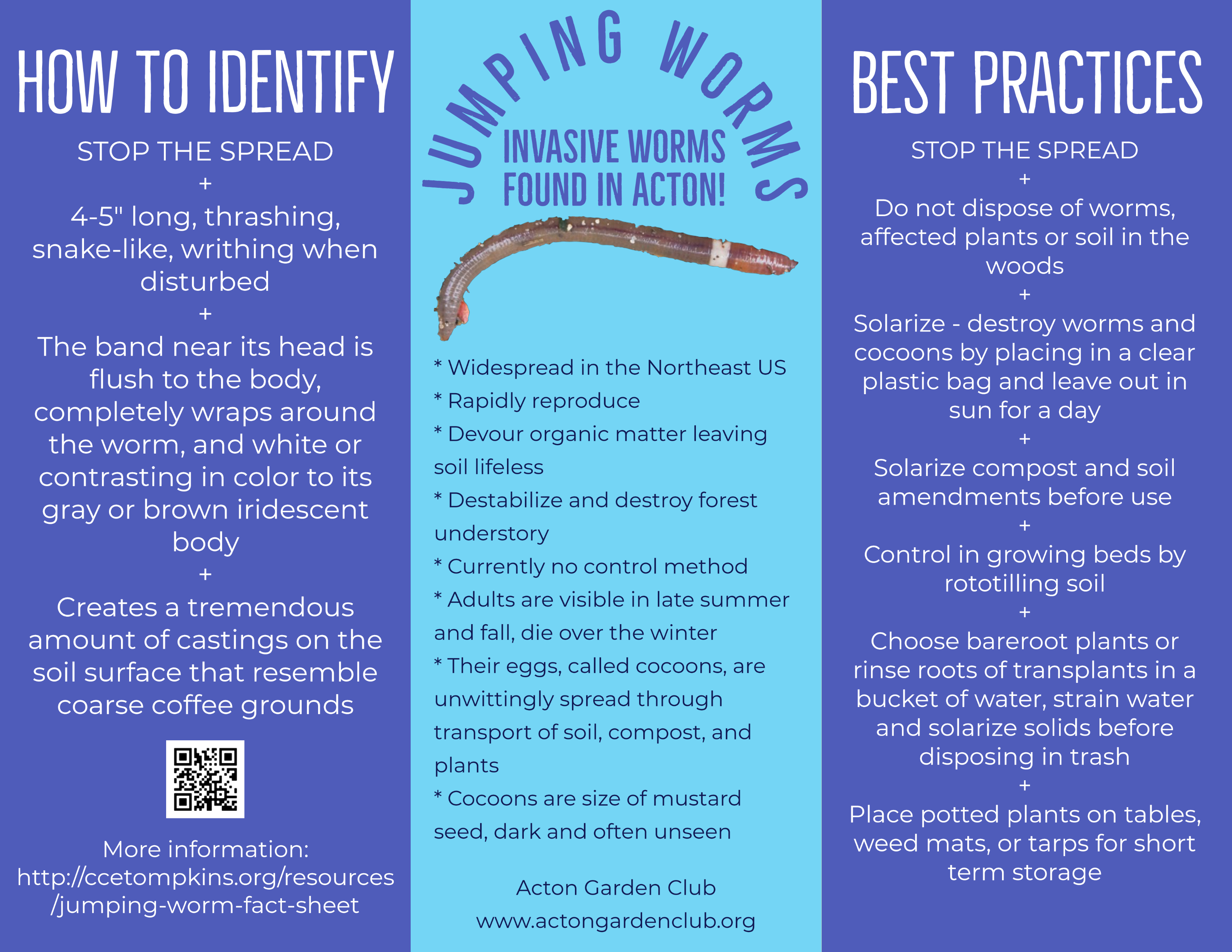Invasive Jumping Worms – Information & Best Practices to Stop the Spread
The Acton Garden Club is taking steps to educate its members and the public about the presence of invasive Asian jumping worms in our community.
For the Acton Garden Club Plant Sale, we are following these procedures to minimize the transfer of jumping worm cocoons:
• Removing the soil from the roots of freshly dug plants by dunking them in a bucket of water. Straining water to remove any eggs, placing debris in a clear plastic bag and leaving out in sun for a day. This should destroy any Jumping Worm eggs.
• Potting in a mix of topsoil and coir (coconut husk), no compost or garden soil.
• We highly recommend that plants not be stored on the ground, but raised up on tables, or placed in the center of a tarp laid on the ground.
Our Jumping Worm flyer summarizes the information and best practices that were explained at the UMASS Extension Jumping Worm Conference on January 26-27, 2022, by four scientists studying Asian earthworms.
o Dr. Olga Kostromytska, UMASS Amherst Entomologist
o Dr. Justin B. Richardson, UMASS Amherst Assistant Professor
o Dr. Josef Gorres, University of Vermont Plant & Soil Science
o Annise Dobson, PhD, Yale School of the Environment
We encourage you to read and follow the recommendations made by these scientists.

Click here to open the AGC Jumping Worm Flyer in PDF
The Fact Sheet listed on the flyer was co-authored by Dr. Annise Dobson and describes a technique to drive worms out of the soil to detect their presence.
Link to http://ccetompkins.org/resources/jumping-worm-fact-sheet here
Interestingly, the three species of Asian worms that are so invasive here in the United States are not threatening the environment in their places of origin. There are many more competing worm species in Japan and Korea, and they are found mainly by roadsides but not in the abundance found here. They feed on the grounds of certain native flora there but not invasively. They are spreading alarmingly here and are especially worrisome in the forests. For example, the sugar maple seedlings in Vermont are seriously threatened. It is vitally important that plant debris containing worms and their cocoons are not tossed into the woods.
Dr. Annise Dobson, of Yale School of the Environment, answered the question, “What can I do?”, by emphasizing prevention. Be mindful of human mediated transport. Plant bare root. Rinse potted plants roots and strain the debris from the rinse water carefully (with a rice strainer). Place debris in a clear plastic bag and solarize for a day. Visually inspect your gardens and landscape for signs of jumping worms. Temporarily store potted plants on tables, on weed mats or on tarps, not directly on the ground where they could be accessed by jumping worms.
If you have worms, Dr. Josef Gorres of UMASS Amherst Plant & Soil Sciences recommended cultural practices to control jumping worms in garden beds. He suggested using tillage – rototilling mid-May to mid-June, before Memorial Day. This would be most appropriate for annual vegetable and flower beds that are replanted each year. The worms are epigeic – they feed on the surface, unlike other worm species that may burrow and feed in-ground. Doing this several years in a row should reduce their numbers. It was also noted that slicing them close to the clitellum (the contrasting band close to their head) is advisable because if they are cut lower on the body, they may lose their tail but survive.
Dr. Gorres also recommended solarizing soil amendments by spreading them outside on a clear plastic painter’s drop cloth. Cover them with another drop cloth and allow them to heat in the sun for a day. Worms and their cocoons are killed at 105 degrees F and above. If you collect worms or rinse soil from transplanted plants, place the debris in a clear plastic bag and leave in the sun to solarize for a day.
The scientists emphasized that they are searching for control methods, but there are no effective treatments for controlling jumping worms at this time. Education, prevention, and best practices are our best strategies until more research is done.
Additional Sources:
UMass Extension:
https://ag.umass.edu/landscape/fact-sheets/jumpingcrazysnake-worms-amynthas-spp
Cornell Cooperative Extension:
http://ulster.cce.cornell.edu/environment/invasive-pests/jumping-worm
http://ccetompkins.org/resources/jumping-worm-fact-sheet
Entomology Research Laboratory at University of Vermont:
https://www.uvm.edu/~entlab/Forest%20IPM/Worms/InvasiveWorms.html
UConn Agricultural Experiment Station:
https://portal.ct.gov/-/media/CAES/DOCUMENTS/Publications/Fact_Sheets/Entomology/Jumping-worms-in-Connecticut.pdf
